Quantum Optics in Nanostructures
Abstract
1. Introduction
2. The Near Field of an NP in an External Electromagnetic Field
Polarization of the Near Field of an NP
3. Spontaneous Emission of Radiation of a QE Near an NP
3.1. Classical Approach
3.2. Quantum Approach
3.3. Studies of QEs Near NPs and on Substrates
4. Quantum Optics of a QE in the Near Field of an NP
4.1. Spectrum of Resonance Fluorescence of QEs
4.2. Statistics of Photons of the Resonance Fluorescence Spectrum of a QE
4.3. Antibunching of Resonance Fluorescence Photons of a QE
4.4. Formation of Squeezed States of Light
4.5. Generation of Entangled Quantum States
5. Conclusions
Author Contributions
Funding
Acknowledgments
Conflicts of Interest
References
- Diedrich, F.; Walther, H. Nonclassical radiation of a single stored ion. Phys. Rev. Lett. 1987, 58, 203–206. [Google Scholar] [CrossRef]
- Short, R.; Mandel, L. Observation of Sub-Poissonian Photon Statistics. Phys. Rev. Lett. 1983, 51, 384–387. [Google Scholar] [CrossRef]
- Kimble, H.J.; Dagenais, M.; Mandel, L. Photon Antibunching in Resonance Fluorescence. Phys. Rev. Lett. 1977, 39, 691–695. [Google Scholar] [CrossRef]
- Gaponenko, S. Introduction to Nanophotonics; Cambridge University Press: New York, NY, USA, 2010. [Google Scholar]
- Tame, M.S.; McEnery, K.R.; Özdemir, S.K.; Lee, J.; Maier, S.A.; Kim, M.S. Quantum Plasmonics. Nat. Phys. 2013, 9, 329–340. [Google Scholar] [CrossRef]
- Liu, N.; Guo, H.; Fu, L.; Kaiser, S.; Schweizer, H.; Giessen, H. Three-dimensional photonic metamaterials at optical frequencies. Nat. Mater. 2008, 7, 31–37. [Google Scholar] [CrossRef]
- Hatab, N.A.; Hsueh, C.H.; Gaddis, A.L.; Retterer, S.T.; Li, J.H.; Eres, G.; Zhang, Z.; Gu, B. Free-Standing Optical Gold Bowtie Nanoantenna with Variable Gap Size for Enhanced Raman Spectroscopy. Nano Lett. 2010, 10, 4952–4955. [Google Scholar] [CrossRef]
- Nien, L.W.; Lin, S.C.; Chao, B.K.; Chen, M.J.; Li, J.H.; Hsueh, C.H. Giant Electric Field Enhancement and Localized Surface Plasmon Resonance by Optimizing Contour Bowtie Nanoantennas. J. Phys. Chem. C 2013, 117, 25004–25011. [Google Scholar] [CrossRef]
- Purcell, E.M.; Torrey, H.C.; Pound, R.V. Resonance Absorption by Nuclear Magnetic Moments in a Solid. Phys. Rev. 1946, 69, 37–38. [Google Scholar] [CrossRef]
- Krasnok, A.E.; Simovski, C.R.; Belov, P.A.; Kivshar, Y.S. Superdirective dielectric nanoantennas. Nanoscale 2014, 6, 7354–7361. [Google Scholar] [CrossRef]
- Alù, A.; Engheta, N. Tuning the scattering response of optical nanoantennas with nanocircuit loads. Nat. Photonics 2008, 2, 307–310. [Google Scholar] [CrossRef]
- Engheta, N. Circuits with Light at Nanoscales: Optical Nanocircuits Inspired by Metamaterials. Science 2007, 317, 1698–1702. [Google Scholar] [CrossRef]
- Guo, R.; Decker, M.; Setzpfandt, F.; Staude, I.; Neshev, D.N.; Kivshar, Y.S. Plasmonic Fano Nanoantennas for On-Chip Separation of Wavelength-Encoded Optical Signals. Nano Lett. 2015, 15, 3324–3328. [Google Scholar] [CrossRef]
- Koenderink, A.F. Plasmon Nanoparticle Array Waveguides for Single Photon and Single Plasmon Sources. Nano Lett. 2009, 9, 4228–4233. [Google Scholar] [CrossRef] [PubMed]
- Nayak, P.K.; Mahesh, S.; Snaith, H.J.; Cahen, D. Photovoltaic solar cell technologies: Analysing the state of the art. Nat. Rev. Mater. 2019, 4, 269–285. [Google Scholar] [CrossRef]
- Vladimirova, Y.V.; Mannanov, A.L.; Zadkov, V.N.; Song, F. Improved Performance of Organic Star-Shaped Molecule Solar Cells with SiO2 Nanoparticles Embedded in a Buffer Layer. Mosc. Univ. Phys. Bull. 2018, 73, 678–682. [Google Scholar] [CrossRef]
- Gollu, S.R.; Sharma, R.; Srinivas, G.; Kundu, S.; Gupta, D. Incorporation of SiO2 dielectric nanoparticles for performance enhancement in P3HT:PCBM inverted organic solar cells. Org. Electron. 2015, 24, 43–50. [Google Scholar] [CrossRef]
- Zhang, R.; Zhou, Y.; Peng, L.; Li, X.; Chen, S.; Feng, X.; Guan, Y.; Huang, W. Influence of SiO2 shell thickness on power conversion efficiency in plasmonic polymer solar cells with Au nanorod@SiO2 core-shell structures. Sci. Rep. 2016, 6, 25036. [Google Scholar] [CrossRef] [PubMed]
- Prasetio, A.; Kim, S.; Jahandar, M.; Lim, D.C. Single particle dual plasmonic effect for efficient organic solar cells. Appl. Nanosci. 2021. [Google Scholar] [CrossRef]
- West, J.L.; Halas, N.J. Engineered nanomaterials for biophotonics applications: Improving sensing, imaging, and therapeutics. Ann. Rev. Biomed. Eng. 2003, 5, 285–292. [Google Scholar] [CrossRef] [PubMed]
- Tam, F.; Goodrich, G.P.; Johnson, B.R.; Halas, N.J. Plasmonic Enhancement of Molecular Fluorescence. Nano Lett. 2007, 7, 496–501. [Google Scholar] [CrossRef]
- Hirsch, L.R.; Stafford, R.J.; Bankson, J.A.; Sershen, S.R.; Rivera, B.; Price, R.E.; Hazle, J.D.; Halas, N.J.; West, J.L. Nanoshell-mediated near-infrared thermal therapy of tumors under magnetic resonance guidance. Proc. Natl. Acad. Sci. USA 2003, 100, 13549–13554. [Google Scholar] [CrossRef] [PubMed]
- Loo, C.; Lowery, A.; Halas, N.; West, J.; Drezek, R. Immunotargeted Nanoshells for Integrated Cancer Imaging and Therapy. Nano Lett. 2005, 5, 709–711. [Google Scholar] [CrossRef]
- O’Neal, D.; Hirsch, L.R.; Halas, N.J.; Payne, J.; West, J.L. Photo-thermal tumor ablation in mice using near infrared-absorbing nanoparticles. Cancer Lett. 2004, 209, 171–176. [Google Scholar] [CrossRef]
- Vesseur, E.J.R.; De Waele, R.; Kuttge, M.; Polman, A. Direct Observation of Plasmonic Modes in Au Nanowires Using High-Resolution Cathodoluminescence Spectroscopy. Nano Lett. 2007, 7, 2843–2846. [Google Scholar] [CrossRef] [PubMed]
- Krasnok, A.E.; Maksymov, I.S.; Denisyuk, A.I.; Belov, P.A.; Miroshnichenko, A.E.; Simovskii, C.R.; Kivshar, Y.S. Optical nanoantennas. Phys. Usp. 2013, 56, 539–564. [Google Scholar] [CrossRef]
- Klimov, V.V. Nanoplasmonics. Phys. Usp. 2008, 51, 839–844. [Google Scholar] [CrossRef]
- Lepeshov, S.I.; Krasnok, A.E.; Belov, P.A.; Miroshnichenko, A.E. Hybrid nanophotonics. Phys. Usp. 2018, 61, 1035–1050. [Google Scholar] [CrossRef]
- Novotny, L.; Van Hulst, N. Antennas for light. Nat. Photonics 2011, 5, 83–90. [Google Scholar] [CrossRef]
- Hernandez, F.E. Reviews in Plasmonics; Springer: New York, NY, USA, 2012. [Google Scholar]
- Novotny, L.A.; Hecht, B. Principles of Nano-Optics; Cambridge University Press: New York, NY, USA, 2012. [Google Scholar]
- Maier, S.A. Plasmonics: Fundamentals and Applications; Springer: New York, NY, USA, 2007. [Google Scholar]
- Klimov, V.V. Nanoplasmonics; Pan Sanford Publishing: Singapore, 2014. [Google Scholar]
- Boltasseva, A.; Atwater, H.A. Low-Loss Plasmonic Metamaterials. Science 2011, 331, 290–291. [Google Scholar] [CrossRef] [PubMed]
- Boriskina, S.V.; Cooper, T.A.; Zeng, L.; Ni, G.; Tong, J.K.; Tsurimaki, Y.; Huang, Y.; Meroueh, L.; Mahan, G.; Chen, G. Losses in plasmonics: From mitigating energy dissipation to embracing loss-enabled functionalities. Adv. Opt. Photon. 2017, 9, 775–827. [Google Scholar] [CrossRef]
- Mohamed, M.B.; Volkov, V.; Link, S.; El-Sayed, M.A. The ‘lightning’ gold nanorods: Fluorescence enhancement of over a million compared to the gold metal. Chem. Phys. Lett. 2000, 317, 517–523. [Google Scholar] [CrossRef]
- Baffou, G.; Quidant, R. Thermo-plasmonics: Using metallic nanostructures as nano-sources of heat. Laser Photonics Rev. 2013, 7, 171–187. [Google Scholar] [CrossRef]
- Baranov, D.G.; Zuev, D.A.; Lepeshov, S.I.; Kotov, O.V.; Krasnok, A.E.; Evlyukhin, A.B.; Chichkov, B.N. All-dielectric nanophotonics: The quest for better materials and fabrication techniques. Optica 2017, 4, 814–825. [Google Scholar] [CrossRef]
- Mie, G. Beiträge zur Optik trüber Medien, speziell kolloidaler Metallösungen. Ann. Phys. 1908, 330, 377–445. [Google Scholar] [CrossRef]
- Feng, T.; Zhang, W.; Liang, Z.; Xu, Y.; Miroshnichenko, A.E. Isotropic Magnetic Purcell Effect. ACS Photonics 2018, 5, 678–683. [Google Scholar] [CrossRef]
- Zambrana-Puyalto, X.; Bonod, N. Purcell factor of spherical Mie resonators. Phys. Rev. B 2015, 91, 195422. [Google Scholar] [CrossRef]
- Mandel, L.; Wolf, E. Optical Coherence and Quantum Optics; Cambridge University Press: New York, NY, USA, 1995. [Google Scholar]
- Bohren, C.F.; Huffman, D.R. Absorption and Scattering by a Sphere. In Absorption and Scattering of Light by Small Particles; John Wiley & Sons, Ltd.: Hoboken, NJ, USA, 1998; Chapter 4; pp. 82–129. [Google Scholar] [CrossRef]
- Li, L.W. Spheroidal Wave Functions in Electromagnetic Theory; John Wiley & Sons: Hoboken, NJ, USA, 2002. [Google Scholar]
- Falloon, P.E. Theory and Computation of Spheroidal Harmonics with General Arguments. Ph.D. Thesis, The University of Western Australia, Perth, Australia, 2001. [Google Scholar]
- Voitovich, N.N.; Katsenelenbaum, B.Z.; Sivov, A.N. The Generalized Natural-Oscillation Method in Diffraction Theory; Nauka: Moscow, Russia, 1977. [Google Scholar]
- Voitovich, N.N.; Katsenelenbaum, B.Z.; Sivov, A.N. The generalized natural-oscillation method in diffraction theory. Sov. Phys. Usp. 1976, 19, 337–352. [Google Scholar] [CrossRef]
- Setälä, T.; Shevchenko, A.; Kaivola, M.; Friberg, A.T. Degree of polarization for optical near fields. Phys. Rev. E 2002, 66, 016615. [Google Scholar] [CrossRef]
- Chubchev, E.D.; Vladimirova, Y.V.; Zadkov, V.N. Controlling near-field polarization distribution of a plasmonic prolate nanospheroid by its aspect ratio and polarization of the incident electromagnetic field. Opt. Express 2014, 22, 20432–20445. [Google Scholar] [CrossRef]
- Chubchev, E.D.; Vladimirova, Y.V.; Zadkov, V.N. Near-field polarization of a plasmonic prolate nanospheroid in a Gaussian beam. Laser Phys. Lett. 2014, 12, 015302. [Google Scholar] [CrossRef]
- Grigoriev, K.S.; Kuznetsov, N.Y.; Vladimirova, Y.V.; Makarov, V.A. Fine characteristics of polarization singularities in a three-dimensional electromagnetic field and their properties in the near field of a metallic nanospheroid. Phys. Rev. A 2018, 98, 063805. [Google Scholar] [CrossRef]
- Kumar, G.V.P. Plasmonic nano-architectures for surface enhanced Raman scattering: A review. J. Nanophotonics 2012, 6, 064503. [Google Scholar] [CrossRef]
- Vladimirova, Y.V.; Pavlov, A.A.; Zadkov, V.N. The Effect of a Silicon Substrate on the Directivity Pattern of Scattered Radiation of a Gold Nanospheroid and on Near-Field Polarization. Mosc. Univ. Phys. Bull. 2017, 72, 544–549. [Google Scholar] [CrossRef]
- Reshetov, S.; Vladimirova, Y.; Gevorkian, L.; Zadkov, V. Near-field polarization distribution of Si nanoparticles near substrate. EPJ Web Conf. 2017, 132, 03006. [Google Scholar] [CrossRef]
- Vladimirova, Y.V.; Arakcheev, V.G.; Song, F.; Zadkov, V.N. Near-field polarization of a high-refractive-index dielectric nanosphere on a dielectric substrate. Phys. Rev. A 2019, 100, 023847. [Google Scholar] [CrossRef]
- Kuznetsov, N.Y.; Grigoriev, K.S.; Vladimirova, Y.V.; Makarov, V.A. Three-dimensional structure of polarization singularities of a light field near a dielectric spherical nanoparticle. Opt. Express 2020, 28, 27293–27299. [Google Scholar] [CrossRef]
- Alferov, Z.I. Nobel Lecture: The double heterostructure concept and its applications in physics, electronics, and technology. Rev. Mod. Phys. 2001, 73, 767–782. [Google Scholar] [CrossRef]
- Wu, D.; Sedgwick, A.C.; Gunnlaugsson, T.; Akkaya, E.U.; Yoon, J.; James, T.D. Fluorescent chemosensors: The past, present and future. Chem. Soc. Rev. 2017, 46, 7105–7123. [Google Scholar] [CrossRef]
- Stehr, F.; Stein, J.; Schueder, F.; Schwille, P.; Jungmann, R. Flat-top TIRF illumination boosts DNA-PAINT imaging and quantification. Nat. Commun. 2019, 10, 1268. [Google Scholar] [CrossRef] [PubMed]
- Ray, S.; Widom, J.R.; Walter, N.G. Life under the Microscope: Single-Molecule Fluorescence Highlights the RNA World. Chem. Rev. 2018, 118, 4120–4155. [Google Scholar] [CrossRef]
- Ecker, J.R.; Geschwind, D.H.; Kriegstein, A.R.; Ngai, J.; Osten, P.; Polioudakis, D.; Regev, A.; Sestan, N.; Wickersham, I.R.; Zeng, H.; et al. The BRAIN Initiative Cell Census Consortium: Lessons Learned toward Generating a Comprehensive Brain Cell Atlas. Neuron 2017, 96, 542–557. [Google Scholar] [CrossRef] [PubMed]
- Andersen, C.M.; Mortensen, G. Fluorescence Spectroscopy: A Rapid Tool for Analyzing Dairy Products. J. Agric. Food Chem. 2008, 56, 720–729. [Google Scholar] [CrossRef] [PubMed]
- Tiguntseva, E.Y.; Zograf, G.P.; Komissarenko, F.E.; Zuev, D.A.; Zakhidov, A.A.; Makarov, S.V.; Kivshar, Y.S. Light-Emitting Halide Perovskite Nanoantennas. Nano Lett. 2018, 18, 1185–1190. [Google Scholar] [CrossRef] [PubMed]
- Koenderink, A.F. On the use of Purcell factors for plasmon antennas. Opt. Lett. 2010, 35, 4208–4210. [Google Scholar] [CrossRef]
- Sauvan, C.; Hugonin, J.P.; Maksymov, I.S.; Lalanne, P. Theory of the Spontaneous Optical Emission of Nanosize Photonic and Plasmon Resonators. Phys. Rev. Lett. 2013, 110, 237401. [Google Scholar] [CrossRef]
- Klimov, V.V.; Letokhov, V.S.; Ducloy, M. Vacuum Rabi splitting of energy levels in a strongly coupled system of a two-level atom and dielectric microsphere. Phys. Rev. A 1997, 56, 2308–2315. [Google Scholar] [CrossRef]
- Klimov, V.V.; Letokhov, V.S. Vacuum splitting of the energy levels of a system consisting of an atom and a dielectric microsphere. J. Exp. Theor. Phys. 1997, 84, 24–28. [Google Scholar] [CrossRef]
- Klimov, V.V.; Ducloy, M.; Letokhov, V.S. Vacuum Rabi splitting of an atom dipole near a dielectric microsphere. J. Mod. Opt. 1997, 44, 1081–1092. [Google Scholar] [CrossRef]
- Klimov, V.V.; Ducloy, M.; Letokhov, V.S. Strong interaction between a two-level atom and the whispering-gallery modes of a dielectric microsphere: Quantum-mechanical consideration. Phys. Rev. A 1999, 59, 2996–3014. [Google Scholar] [CrossRef]
- Haroche, S. Fundamental Systems in Quantum Optics; Dalibard, J., Raimond, J.M., Justin, J.Z., Eds.; Elsevier Science Publishers: Amsterdam, The Netherlands, 1992. [Google Scholar]
- Klimov, V.V. Spontaneous emission of an atom in the presence of nanobodies. Quantum Electron. 2001, 31, 569. [Google Scholar] [CrossRef]
- Klimov, V.V. Spontaneous atomic radiation in the presence of nanobodies. Phys. Usp. 2003, 46, 979–984. [Google Scholar] [CrossRef]
- Wylie, J.M.; Sipe, J.E. Quantum electrodynamics near an interface. Phys. Rev. A 1984, 30, 1185–1193. [Google Scholar] [CrossRef]
- Dung, H.T.; Knöll, L.; Welsch, D.G. Spontaneous decay in the presence of dispersing and absorbing bodies: General theory and application to a spherical cavity. Phys. Rev. A 2000, 62, 053804. [Google Scholar] [CrossRef]
- Knoll, L.; Scheel, S.; Welsch, D.-G. QED in dispersing and absorbing media. arXiv 2000, arXiv:quant-ph/000621-27. [Google Scholar]
- Yeung, M.S.; Gustafson, T.K. Spontaneous emission near an absorbing dielectric surface. Phys. Rev. A 1996, 54, 5227–5242. [Google Scholar] [CrossRef]
- Drexhage, K.H.; Fleck, M.; Schäfer, F.P.; Sperling, W. Beeinflussung der Fluoreszenz eines Europium-chelates durch einen Spiegel. Ber. Bunsenges. Phys. Chem. 1966, 20, 1176. [Google Scholar]
- Goy, P.; Raimond, J.M.; Gross, M.; Haroche, S. Observation of Cavity-Enhanced Single-Atom Spontaneous Emission. Phys. Rev. Lett. 1983, 50, 1903–1906. [Google Scholar] [CrossRef]
- Kleppner, D. Inhibited Spontaneous Emission. Phys. Rev. Lett. 1981, 47, 233–236. [Google Scholar] [CrossRef]
- Andrew, P. Forster Energy Transfer in an Optical Microcavity. Science 2000, 290, 785–788. [Google Scholar] [CrossRef]
- Pohl, D.W. Near-Field Optics: Principles and Applications; World Scientific: Singapore, 2000; pp. 9–21. [Google Scholar]
- Anger, P.; Bharadwaj, P.; Novotny, L. Enhancement and Quenching of Single-Molecule Fluorescence. Phys. Rev. Lett. 2006, 96, 113002. [Google Scholar] [CrossRef]
- Kühn, S.; Håkanson, U.; Rogobete, L.; Sandoghdar, V. Enhancement of Single-Molecule Fluorescence Using a Gold Nanoparticle as an Optical Nanoantenna. Phys. Rev. Lett. 2006, 97, 017402. [Google Scholar] [CrossRef] [PubMed]
- Girard, C.; Martin, O.J.; Lévèque, G.; Des Francs, G.C.; Dereux, A. Generalized bloch equations for optical interactions in confined geometries. Chem. Phys. Lett. 2005, 404, 44–48. [Google Scholar] [CrossRef][Green Version]
- Koenderink, A.F. Single-Photon Nanoantennas. ACS Photonics 2017, 4, 710–722. [Google Scholar] [CrossRef] [PubMed]
- Sullivan, K.G.; Hall, D.G. Enhancement and inhibition of electromagnetic radiation in plane-layered media. I. Plane-wave spectrum approach to modeling classical effects. J. Opt. Soc. Am. B 1997, 14, 1149–1159. [Google Scholar] [CrossRef]
- Amos, R.M.; Barnes, W.L. Modification of the spontaneous emission rate of Eu3+ ions close to a thin metal mirror. Phys. Rev. B 1997, 55, 7249–7254. [Google Scholar] [CrossRef]
- Chance, R.R.; Prock, A.; Silbey, R. Molecular Fluorescence and Energy Transfer Near Interfaces. In Advances in Chemical Physics; John Wiley & Sons, Ltd.: Hoboken, NJ, USA, 1978; pp. 1–65. [Google Scholar] [CrossRef]
- Wu, S.T.; Eberlein, C. Quantum electrodynamics of an atom in front of a nondispersive dielectric halfspace. Proc. R. Soc. Lond. Ser. A Math. Phys. Eng. Sci. 1999, 455, 2487–2512. [Google Scholar] [CrossRef]
- Chew, H. Transition rates of atoms near spherical surfaces. J. Chem. Phys. 1987, 87, 1355–1360. [Google Scholar] [CrossRef]
- Klimov, V.V.; Ducloy, M.; Letokhov, V.S. Radiative frequency shift and linewidth of an atom dipole in the vicinity of a dielectric microsphere. J. Mod. Opt. 1996, 43, 2251–2267. [Google Scholar] [CrossRef]
- Kasenelenbaum, B.Z. The title of the work. J. Tech. Phys. 1949, 19, 1182. [Google Scholar]
- Nha, H.; Jhe, W. Cavity quantum electrodynamics for a cylinder: Inside a hollow dielectric and near a solid dielectric cylinder. Phys. Rev. A 1997, 56, 2213–2220. [Google Scholar] [CrossRef]
- Corni, S.; Tomasi, J. Lifetimes of electronic excited states of a molecule close to a metal surface. J. Chem. Phys. 2003, 118, 6481–6494. [Google Scholar] [CrossRef]
- Żakowicz, W.; Janowicz, M. Spontaneous emission in the presence of a dielectric cylinder. Phys. Rev. A 2000, 62, 013820. [Google Scholar] [CrossRef]
- Klimov, V.V.; Ducloy, M. Allowed and forbidden transitions in an atom placed near an ideally conducting cylinder. Phys. Rev. A 2000, 62, 043818. [Google Scholar] [CrossRef]
- Klimov, V.V.; Ducloy, M.; Letokhov, V.S. Spontaneous emission of an atom placed near a prolate nanospheroid. Eur. Phys. J. D 2002, 20, 133–148. [Google Scholar] [CrossRef]
- Klimov, V.; Ducloy, M.; Letokhov, V. A model of an apertureless scanning microscope with a prolate nanospheroid as a tip and an excited molecule as an object. Chem. Phys. Lett. 2002, 358, 192–198. [Google Scholar] [CrossRef]
- Klimov, V.V. Spontaneous emission from an atomic oscillator located near an ideally conducting conical surface. JETP Lett. 1998, 68, 641–645. [Google Scholar] [CrossRef]
- Klimov, V.V.; Perventsev, Y.A. Variation of the emission characteristics of an atom located near an ideally conducting conical surface. Quantum Electron. 1999, 29, 847–851. [Google Scholar] [CrossRef]
- Zijlstra, P.; Paulo, P.M.R.; Orrit, M. Optical detection of single non-absorbing molecules using the surface plasmon resonance of a gold nanorod. Nat. Nanotechnol. 2012, 7, 379–382. [Google Scholar] [CrossRef]
- Kinkhabwala, A.; Yu, Z.; Fan, S.; Avlasevich, Y.; Müllen, K.; Moerner, W.E. Large single-molecule fluorescence enhancements produced by a bowtie nanoantenna. Nat. Photonics 2009, 3, 654–657. [Google Scholar] [CrossRef]
- Punj, D.; Mivelle, M.; Moparthi, S.B.; Van Zanten, T.S.; Rigneault, H.; Van Hulst, N.F.; García-Parajó, M.F.; Wenger, J. A plasmonic ‘antenna-in-box’ platform for enhanced single-molecule analysis at micromolar concentrations. Nat. Nanotechnol. 2013, 8, 512–516. [Google Scholar] [CrossRef]
- Karamlou, A.; Trusheim, M.E.; Englund, D. Metal-dielectric antennas for efficient photon collection from diamond color centers. Opt. Express 2018, 26, 3341–3352. [Google Scholar] [CrossRef]
- Guzatov, D.V.; Klimov, V.V.; Pikhota, M.Y. Plasmon oscillations in ellipsoid nanoparticles: Beyond dipole approximation. Laser Phys. 2010, 20, 85–99. [Google Scholar] [CrossRef][Green Version]
- Guzatov, D.; Klimov, V. Radiative decay engineering by triaxial nanoellipsoids. Chem. Phys. Lett. 2005, 412, 341–346. [Google Scholar] [CrossRef]
- Guzatov, D.V.; Klimov, V.V. Optical properties of a plasmonic nano-antenna: An analytical approach. New J. Phys. 2011, 13, 053034. [Google Scholar] [CrossRef]
- Klimov, V.; Guzatov, D. Plasmonic atoms and plasmonic molecules. Appl. Phys. A 2007, 89, 305–314. [Google Scholar] [CrossRef]
- Curto, A.G.; Volpe, G.; Taminiau, T.H.; Kreuzer, M.P.; Quidant, R.; van Hulst, N.F. Unidirectional Emission of a Quantum Dot Coupled to a Nanoantenna. Science 2010, 329, 930–933. [Google Scholar] [CrossRef] [PubMed]
- Aouani, H.; Mahboub, O.; Devaux, E.; Rigneault, H.; Ebbesen, T.W.; Wenger, J. Plasmonic Antennas for Directional Sorting of Fluorescence Emission. Nano Lett. 2011, 11, 2400–2406. [Google Scholar] [CrossRef] [PubMed]
- Langguth, L.; Punj, D.; Wenger, J.; Koenderink, A.F. Plasmonic Band Structure Controls Single-Molecule Fluorescence. ACS Nano 2013, 7, 8840–8848. [Google Scholar] [CrossRef] [PubMed]
- Belacel, C.; Habert, B.; Bigourdan, F.; Marquier, F.; Hugonin, J.P.; Michaelis de Vasconcellos, S.; Lafosse, X.; Coolen, L.; Schwob, C.; Javaux, C.; et al. Controlling Spontaneous Emission with Plasmonic Optical Patch Antennas. Nano Lett. 2013, 13, 1516–1521. [Google Scholar] [CrossRef]
- Yi, J.M.; Cuche, A.; Devaux, E.; Genet, C.; Ebbesen, T.W. Beaming Visible Light with a Plasmonic Aperture Antenna. ACS Photonics 2014, 1, 365–370. [Google Scholar] [CrossRef]
- Hoang, T.B.; Akselrod, G.M.; Mikkelsen, M.H. Ultrafast Room-Temperature Single Photon Emission from Quantum Dots Coupled to Plasmonic Nanocavities. Nano Lett. 2016, 16, 270–275. [Google Scholar] [CrossRef]
- Krasnok, A.E.; Miroshnichenko, A.E.; Belov, P.A.; Kivshar, Y.S. All-dielectric optical nanoantennas. Opt. Express 2012, 20, 20599–20604. [Google Scholar] [CrossRef] [PubMed]
- Rolly, B.; Stout, B.; Bonod, N. Boosting the directivity of optical antennas with magnetic and electric dipolar resonant particles. Opt. Express 2012, 20, 20376–20386. [Google Scholar] [CrossRef]
- Rusak, E.; Staude, I.; Decker, M.; Sautter, J.; Miroshnichenko, A.E.; Powell, D.A.; Neshev, D.N.; Kivshar, Y.S. Hybrid nanoantennas for directional emission enhancement. Appl. Phys. Lett. 2014, 105, 221109. [Google Scholar] [CrossRef]
- Regmi, R.; Berthelot, J.; Winkler, P.M.; Mivelle, M.; Proust, J.; Bedu, F.; Ozerov, I.; Begou, T.; Lumeau, J.; Rigneault, H.; et al. All-Dielectric Silicon Nanogap Antennas To Enhance the Fluorescence of Single Molecules. Nano Lett. 2016, 16, 5143–5151. [Google Scholar] [CrossRef]
- Bouchet, D.; Mivelle, M.; Proust, J.; Gallas, B.; Ozerov, I.; Garcia-Parajo, M.F.; Gulinatti, A.; Rech, I.; De Wilde, Y.; Bonod, N.; et al. Enhancement and Inhibition of Spontaneous Photon Emission by Resonant Silicon Nanoantennas. Phys. Rev. Appl. 2016, 6, 064016. [Google Scholar] [CrossRef]
- Vladimirova, Y.V.; Klimov, V.V.; Pastukhov, V.M.; Zadkov, V.N. Modification of two-level-atom resonance fluorescence near a plasmonic nanostructure. Phys. Rev. A 2012, 85, 053408. [Google Scholar] [CrossRef]
- Apanasevich, P.A. Absorption and Transformation of Powerful Radiation Fluxes. I. A Density Matrix Equations and their Application to an Irradiation of the Material with Monochromatic Radiation. Opt. Spectrosc. 1963, 14, 324. [Google Scholar]
- Apanasevich, P.A. Dependence of the profile and width of spectral lines on the strength and frequency of the exciting radiation. Opt. Spectrosc. 1964, 16, 387. [Google Scholar]
- Newstein, M.C. Spontaneous Emission in the Presence of a Prescribed Classical Field. Phys. Rev. 1968, 167, 89–96. [Google Scholar] [CrossRef]
- Mollow, B.R. Power Spectrum of Light Scattered by Two-Level Systems. Phys. Rev. 1969, 188, 1969–1975. [Google Scholar] [CrossRef]
- Bederson, B.; Walther, H. Advances in Atomic, Molecular, and Optical Physics; Elsevier: Amsterdam, The Netherlands, 2005; Volume 51. [Google Scholar]
- Kimble, H.J.; Mandel, L. Theory of resonance fluorescence. Phys. Rev. A 1976, 13, 2123–2144. [Google Scholar] [CrossRef]
- Klimov, V.V.; Letokhov, V.S.; Ducloy, M. Quantum theory of radiation of an excited atom placed near a microresonator containing a single-photon wavepacket: Photon correlation properties. Laser Phys. 2007, 17, 912–926. [Google Scholar] [CrossRef]
- Andrianov, E.S.; Pukhov, A.A.; Vinogradov, A.P.; Dorofeenko, A.V.; Lisyansky, A.A. Modification of the resonance fluorescence spectrum of a two-level atom in the near field of a plasmonic nanoparticle. JETP Lett. 2013, 97, 452–458. [Google Scholar] [CrossRef]
- Trügler, A.; Hohenester, U. Strong coupling between a metallic nanoparticle and a single molecule. Phys. Rev. B 2008, 77, 115403. [Google Scholar] [CrossRef]
- Carreño, F.; Antón, M.A.; Yannopapas, V.; Paspalakis, E. Resonance fluorescence spectrum of a Λ-type quantum emitter close to a metallic nanoparticle. Phys. Rev. A 2016, 94, 013834. [Google Scholar] [CrossRef]
- Carreño, F.; Antón, M.A.; Yannopapas, V.; Paspalakis, E. Control of resonance fluorescence of a four-level quantum emitter near a plasmonic nanostructure. Phys. Rev. A 2017, 95, 043825. [Google Scholar] [CrossRef]
- Sanchez-Munoz, C.; Gonzalez-Tudela, A.; Tejedor, C. Plasmon-polariton emission from a coherently p-excited quantum dot near a metal interface. Phys. Rev. B 2012, 85, 125301. [Google Scholar] [CrossRef]
- Sadeghi, S.M. Quantum coherence effects in hybrid nanoparticle molecules in the presence of ultra-short dephasing times. Appl. Phys. Lett. 2012, 101, 213102. [Google Scholar] [CrossRef]
- Ge, R.C.; Van Vlack, C.; Yao, P.; Young, J.F.; Hughes, S. Accessing quantum nanoplasmonics in a hybrid quantum dot–metal nanosystem: Mollow triplet of a quantum dot near a metal nanoparticle. Phys. Rev. B 2013, 87, 205425. [Google Scholar] [CrossRef]
- Sadeghi, S.M. Ultrafast plasmonic field oscillations and optics of molecular resonances caused by coherent exciton-plasmon coupling. Phys. Rev. A 2013, 88, 013831. [Google Scholar] [CrossRef]
- Słowik, K.; Filter, R.; Straubel, J.; Lederer, F.; Rockstuhl, C. Strong coupling of optical nanoantennas and atomic systems. Phys. Rev. B 2013, 88, 195414. [Google Scholar] [CrossRef]
- Theuerholz, T.S.; Carmele, A.; Richter, M.; Knorr, A. Influence of Förster interaction on light emission statistics in hybrid systems. Phys. Rev. B 2013, 87, 245313. [Google Scholar] [CrossRef]
- Fang, W.; Wu, Q.L.; Wu, S.P.; Li, G.X. Enhancement of squeezing in resonance fluorescence of a driven quantum dot close to a graphene sheet. Phys. Rev. A 2016, 93, 053831. [Google Scholar] [CrossRef]
- Astafiev, O.; Zagoskin, A.M.; Abdumalikov, A.A.; Pashkin, Y.A.; Yamamoto, T.; Inomata, K.; Nakamura, Y.; Tsai, J.S. Resonance Fluorescence of a Single Artificial Atom. Science 2010, 327, 840–843. [Google Scholar] [CrossRef] [PubMed]
- Pastukhov, V.M.; Vladimirova, Y.V.; Zadkov, V.N. Photon-number statistics from resonance fluorescence of a two-level atom near a plasmonic nanoparticle. Phys. Rev. A 2014, 90, 063831. [Google Scholar] [CrossRef]
- Smirnov, D.F.; Troshin, A.S. New phenomena in quantum optics: Photon antibunching, sub-Poisson photon statistics, and squeezed states. Sov. Phys. Usp. 1987, 30, 851–874. [Google Scholar] [CrossRef]
- Carmichael, H.J.; Walls, D.F. A quantum-mechanical master equation treatment of the dynamical Stark effect. J. Phys. B At. Mol. Phys. 1976, 9, 1199–1219. [Google Scholar] [CrossRef]
- Glauber, R.J. The Quantum Theory of Optical Coherence. Phys. Rev. 1963, 130, 2529–2539. [Google Scholar] [CrossRef]
- Carreño, F.; Yannopapas, V.; Antón, M.A.; Paspalakis, E. Photon statistics of a quantum emitter close to a lattice of plasmonic nanoparticles. Phys. Rev. A 2019, 100, 023802. [Google Scholar] [CrossRef]
- Sáez-Blázquez, R.; Feist, J.; García-Vidal, F.J.; Fernández-Domínguez, A.I. Photon statistics in collective strong coupling: Nanocavities and microcavities. Phys. Rev. A 2018, 98, 013839. [Google Scholar] [CrossRef]
- Bordo, V.G. Quantum light from a metal nanoparticle. Phys. Rev. A 2019, 100, 063807. [Google Scholar] [CrossRef]
- Phillips, C.L.; Brash, A.J.; McCutcheon, D.P.S.; Iles-Smith, J.; Clarke, E.; Royall, B.; Skolnick, M.S.; Fox, A.M.; Nazir, A. Photon Statistics of Filtered Resonance Fluorescence. Phys. Rev. Lett. 2020, 125, 043603. [Google Scholar] [CrossRef]
- Mandel, L. Squeezed States and Sub-Poissonian Photon Statistics. Phys. Rev. Lett. 1982, 49, 136–138. [Google Scholar] [CrossRef]
- Walls, D.F.; Zoller, P. Reduced Quantum Fluctuations in Resonance Fluorescence. Phys. Rev. Lett. 1981, 47, 709–711. [Google Scholar] [CrossRef]
- Dhayal, S.; Rostovtsev, Y.V. Effects of quantum coherence and interference in atoms near nanoparticles. Phys. Rev. A 2016, 93, 043405. [Google Scholar] [CrossRef]
- Delga, A.; Feist, J.; Bravo-Abad, J.; Garcia-Vidal, F.J. Quantum Emitters Near a Metal Nanoparticle: Strong Coupling and Quenching. Phys. Rev. Lett. 2014, 112, 253601. [Google Scholar] [CrossRef]
- Ahmad, S. Quantum analysis of plasmonic coupling between quantum dots and nanoparticles. Phys. Rev. A 2016, 94, 043819. [Google Scholar] [CrossRef]
- Chatzidakis, G.D.; Yannopapas, V. Strong electromagnetic coupling in dimers of topological-insulator nanoparticles and quantum emitters. Phys. Rev. B 2020, 101, 165410. [Google Scholar] [CrossRef]
- Reilly, D.J. Engineering the quantum-classical interface of solid-state qubits. Npj Quantum Inf. 2015, 1, 15011. [Google Scholar] [CrossRef]
- Pan, J.W.; Chen, Z.B.; Lu, C.Y.; Weinfurter, H.; Zeilinger, A.; Żukowski, M. Multiphoton entanglement and interferometry. Rev. Mod. Phys. 2012, 84, 777–838. [Google Scholar] [CrossRef]
- Bargatin, I.V.; Grishanin, B.A.; Zadkov, V.N. Entangled quantum states of atomic systems. Phys. Usp. 2001, 44, 597–616. [Google Scholar] [CrossRef]
- Chen, G.Y.; Li, C.M.; Chen, Y.N. Generating maximum entanglement under asymmetric couplings to surface plasmons. Opt. Lett. 2012, 37, 1337–1339. [Google Scholar] [CrossRef] [PubMed]
- Jin, X.R.; Sun, L.; Yang, X.; Gao, J. Quantum entanglement in plasmonic waveguides with near-zero mode indices. Opt. Lett. 2013, 38, 4078–4081. [Google Scholar] [CrossRef]
- Martín-Cano, D.; González-Tudela, A.; Martín-Moreno, L.; García-Vidal, F.J.; Tejedor, C.; Moreno, E. Dissipation-driven generation of two-qubit entanglement mediated by plasmonic waveguides. Phys. Rev. B 2011, 84, 235306. [Google Scholar] [CrossRef]
- Lee, C.; Tame, M.; Noh, C.; Lim, J.; Maier, S.A.; Lee, J.; Angelakis, D.G. Robust-to-loss entanglement generation using a quantum plasmonic nanoparticle array. New J. Phys. 2013, 15, 083017. [Google Scholar] [CrossRef]
- Gullans, M.; Tiecke, T.G.; Chang, D.E.; Feist, J.; Thompson, J.D.; Cirac, J.I.; Zoller, P.; Lukin, M.D. Nanoplasmonic Lattices for Ultracold Atoms. Phys. Rev. Lett. 2012, 109, 235309. [Google Scholar] [CrossRef]
- Hou, J.; Słowik, K.; Lederer, F.; Rockstuhl, C. Dissipation-driven entanglement between qubits mediated by plasmonic nanoantennas. Phys. Rev. B 2014, 89, 235413. [Google Scholar] [CrossRef]
- Nerkararyan, K.V.; Bozhevolnyi, S.I. Entanglement of two qubits mediated by a localized surface plasmon. Phys. Rev. B 2015, 92, 045410. [Google Scholar] [CrossRef]
- Otten, M.; Gray, S.K.; Kolmakov, G.V. Optical detection and storage of entanglement in plasmonically coupled quantum-dot qubits. Phys. Rev. A 2019, 99, 032339. [Google Scholar] [CrossRef]
- Dumitrescu, E.; Lawrie, B. Antibunching dynamics of plasmonically mediated entanglement generation. Phys. Rev. A 2017, 96, 053826. [Google Scholar] [CrossRef]
- Otten, M.; Shah, R.A.; Scherer, N.F.; Min, M.; Pelton, M.; Gray, S.K. Entanglement of two, three, or four plasmonically coupled quantum dots. Phys. Rev. B 2015, 92, 125432. [Google Scholar] [CrossRef]
- Otten, M.; Larson, J.; Min, M.; Wild, S.M.; Pelton, M.; Gray, S.K. Origins and optimization of entanglement in plasmonically coupled quantum dots. Phys. Rev. A 2016, 94, 022312. [Google Scholar] [CrossRef]
- Iliopoulos, N.; Terzis, A.F.; Yannopapas, V.; Paspalakis, E. Prolonging entanglement dynamics near periodic plasmonic nanostructures. Phys. Rev. B 2017, 96, 075405. [Google Scholar] [CrossRef]
- Tang, W.; Lin, F.; Zhu, X.; Fang, Z. Plasmonic-modulated dissipative-driven multiqubit entanglement under asymmetric detuning. Phys. Rev. B 2019, 100, 165415. [Google Scholar] [CrossRef]
- Vidal, G.; Werner, R.F. Computable measure of entanglement. Phys. Rev. A 2002, 65, 032314. [Google Scholar] [CrossRef]
- Valuckas, V.; Paniagua-Domínguez, R.; Fu, Y.H.; Luk’yanchuk, B.; Kuznetsov, A.I. Direct observation of resonance scattering patterns in single silicon nanoparticles. Appl. Phys. Lett. 2017, 110, 091108. [Google Scholar] [CrossRef]
- Zirkelbach, J.; Gmeiner, B.; Renger, J.; Türschmann, P.; Utikal, T.; Götzinger, S.; Sandoghdar, V. Partial Cloaking of a Gold Particle by a Single Molecule. Phys. Rev. Lett. 2020, 125, 103603. [Google Scholar] [CrossRef]
- Fedotov, I.V.; Safronov, N.A.; Shandarov, Y.A.; Lanin, A.A.; Fedotov, A.B.; Kilin, S.Y.; Sakoda, K.; Scully, M.O.; Zheltikov, A.M. Guided-wave-coupled nitrogen vacancies in nanodiamond-doped photonic-crystal fibers. Appl. Phys. Lett. 2012, 101, 031106. [Google Scholar] [CrossRef]
- Lodahl, P.; Mahmoodian, S.; Stobbe, S.; Rauschenbeutel, A.; Schneeweiss, P.; Volz, J.; Pichler, H.; Zoller, P. Chiral quantum optics. Nature 2017, 541, 473–480. [Google Scholar] [CrossRef]
- De Leon, I.; Horton, M.J.; Schulz, S.A.; Upham, J.; Banzer, P.; Boyd, R.W. Strong, spectrally-tunable chirality in diffractive metasurfaces. Sci. Rep. 2015, 5, 13034. [Google Scholar] [CrossRef]
- Guzatov, D.V.; Klimov, V.V. Spontaneous emission of an optically active molecule near a chiral nanoellipsoid. Phys. Rev. A 2018, 98, 013823. [Google Scholar] [CrossRef]
- Klimov, V.V.; Guzatov, D.V. Using chiral nano-meta-particles to control chiral molecule radiation. Phys. Usp. 2012, 182, 1054–1058. [Google Scholar] [CrossRef]
- Klimov, V.V.; Guzatov, D.V. Singular and Chiral Nanoplasmonics; Pan Sanford Publishing: Singapore, 2014; p. 121. [Google Scholar]
- Wozniak, P.; Banzer, P.; Leuchs, G. Selective switching of individual multipole resonances in single dielectric nanoparticles. Laser Photonics Rev. 2015, 9, 231–240. [Google Scholar] [CrossRef]
- Zambrana-Puyalto, X.; Vidal, X.; Wozniak, P.; Banzer, P.; Molina-Terriza, G. Tailoring Multipolar Mie Scattering with Helicity and Angular Momentum. ACS Photonics 2018, 5, 2936–2944. [Google Scholar] [CrossRef]
- Bauer, T.; Orlov, S.; Leuchs, G.; Banzer, P. Towards an optical far-field measurement of higher-order multipole contributions to the scattering response of nanoparticles. Appl. Phys. Lett. 2015, 106, 091108. [Google Scholar] [CrossRef]
- Klimov, V. Manifestation of extremely high-Q pseudo-modes in scattering of a Bessel light beam by a sphere. Opt. Lett. 2020, 45, 4300–4303. [Google Scholar] [CrossRef]
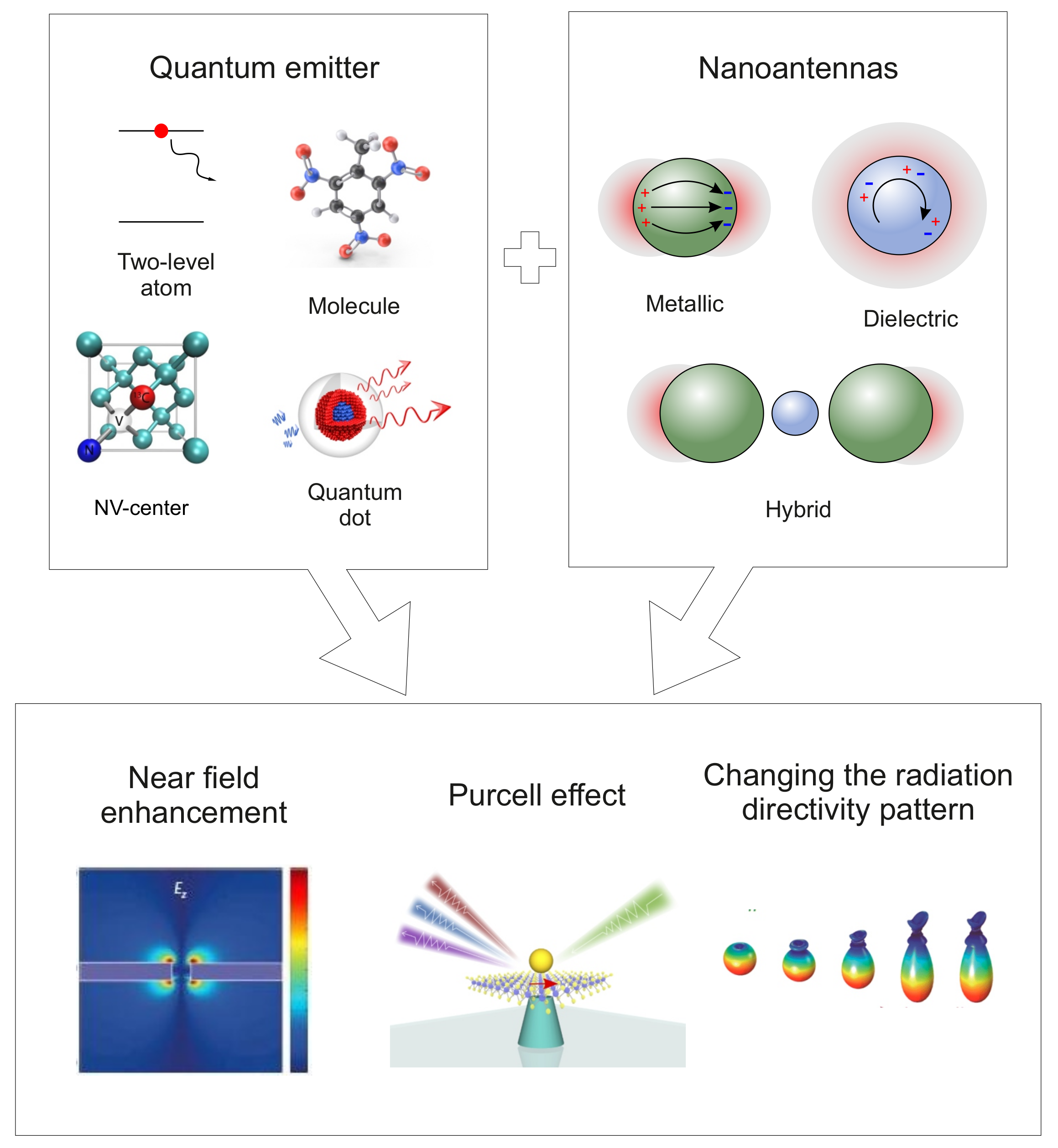
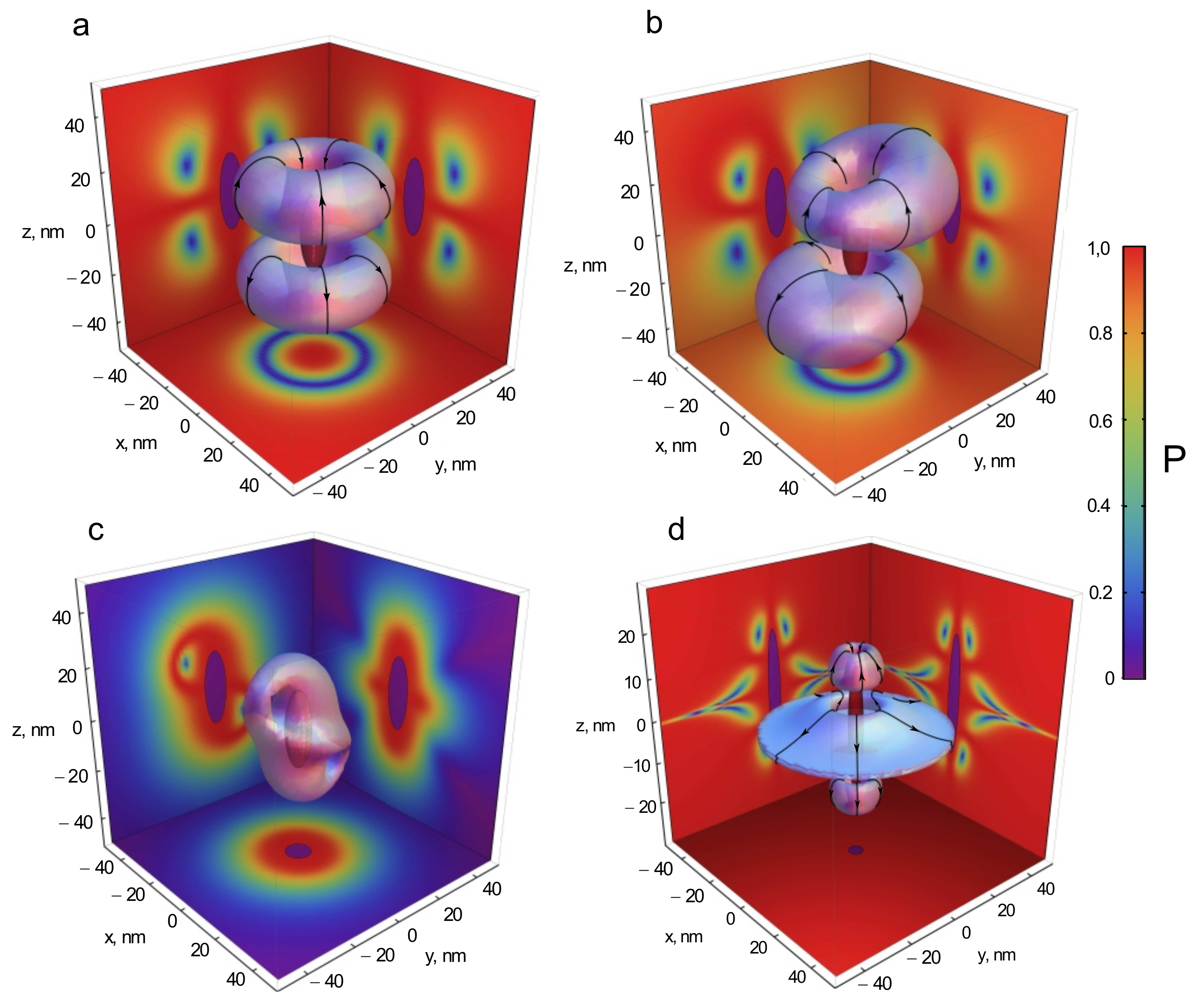
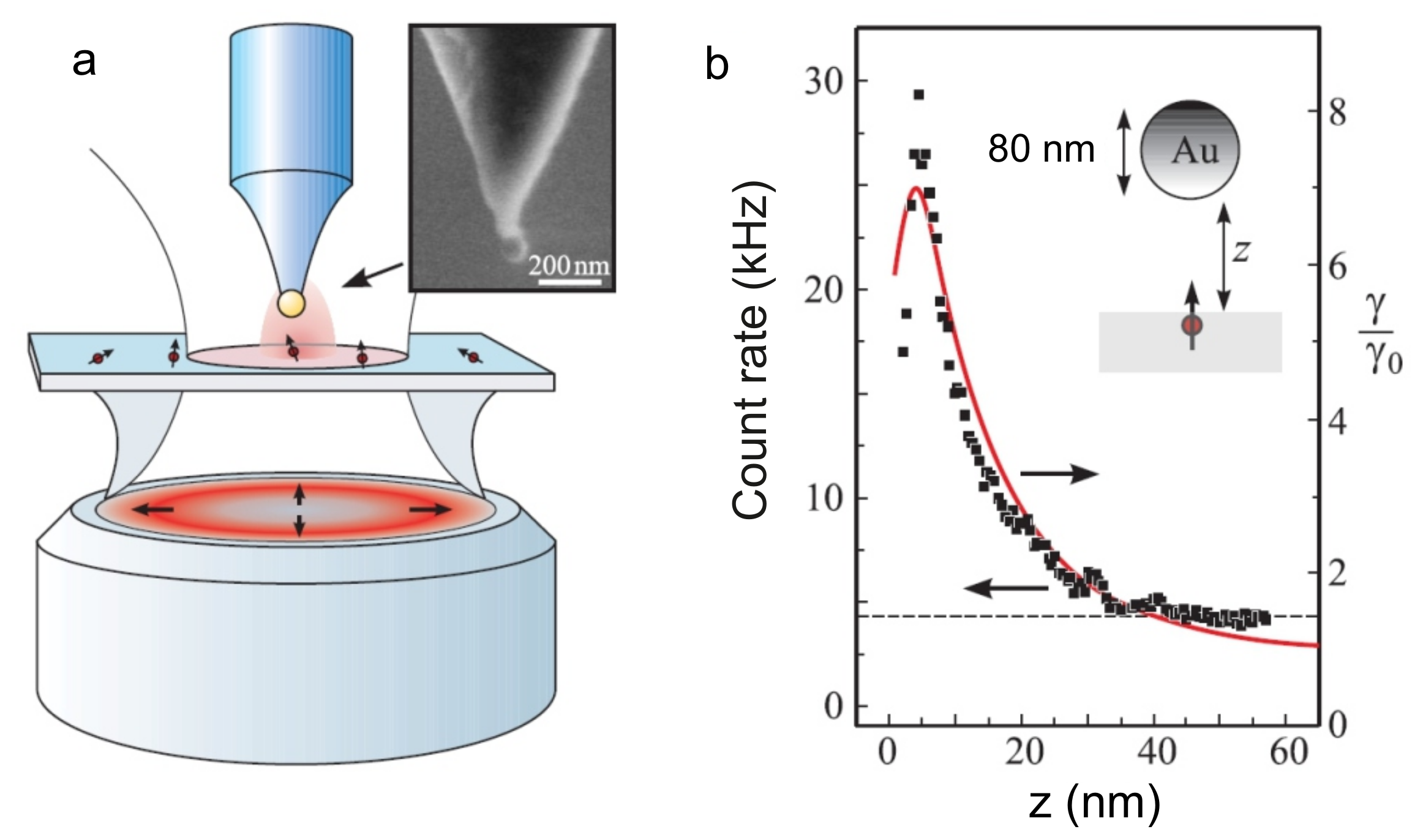

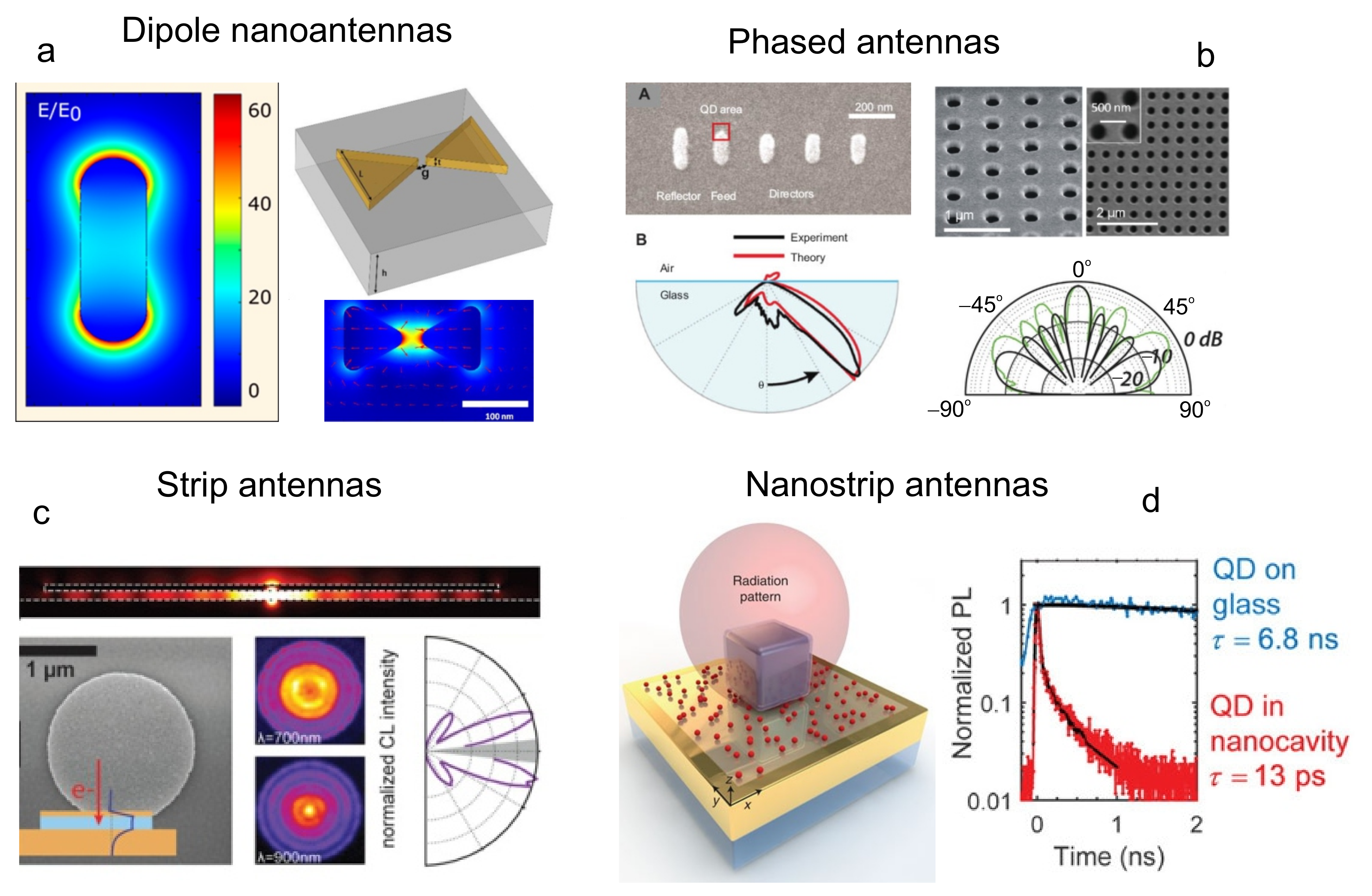
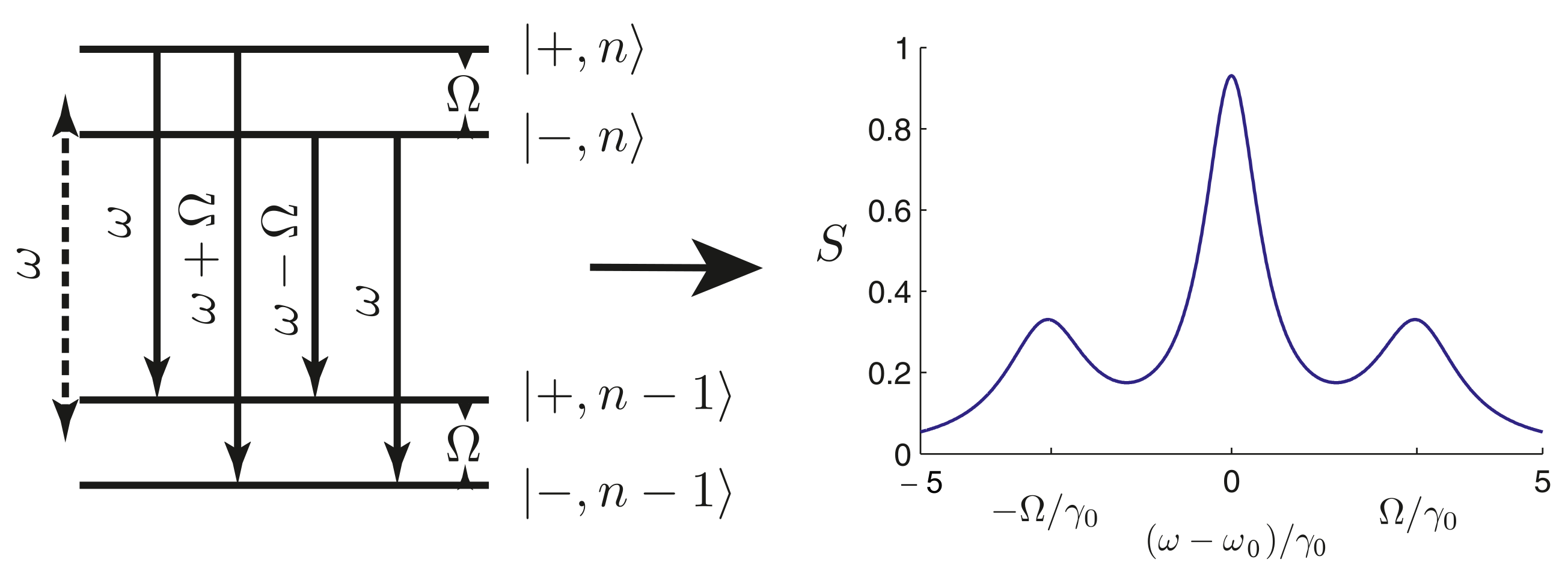
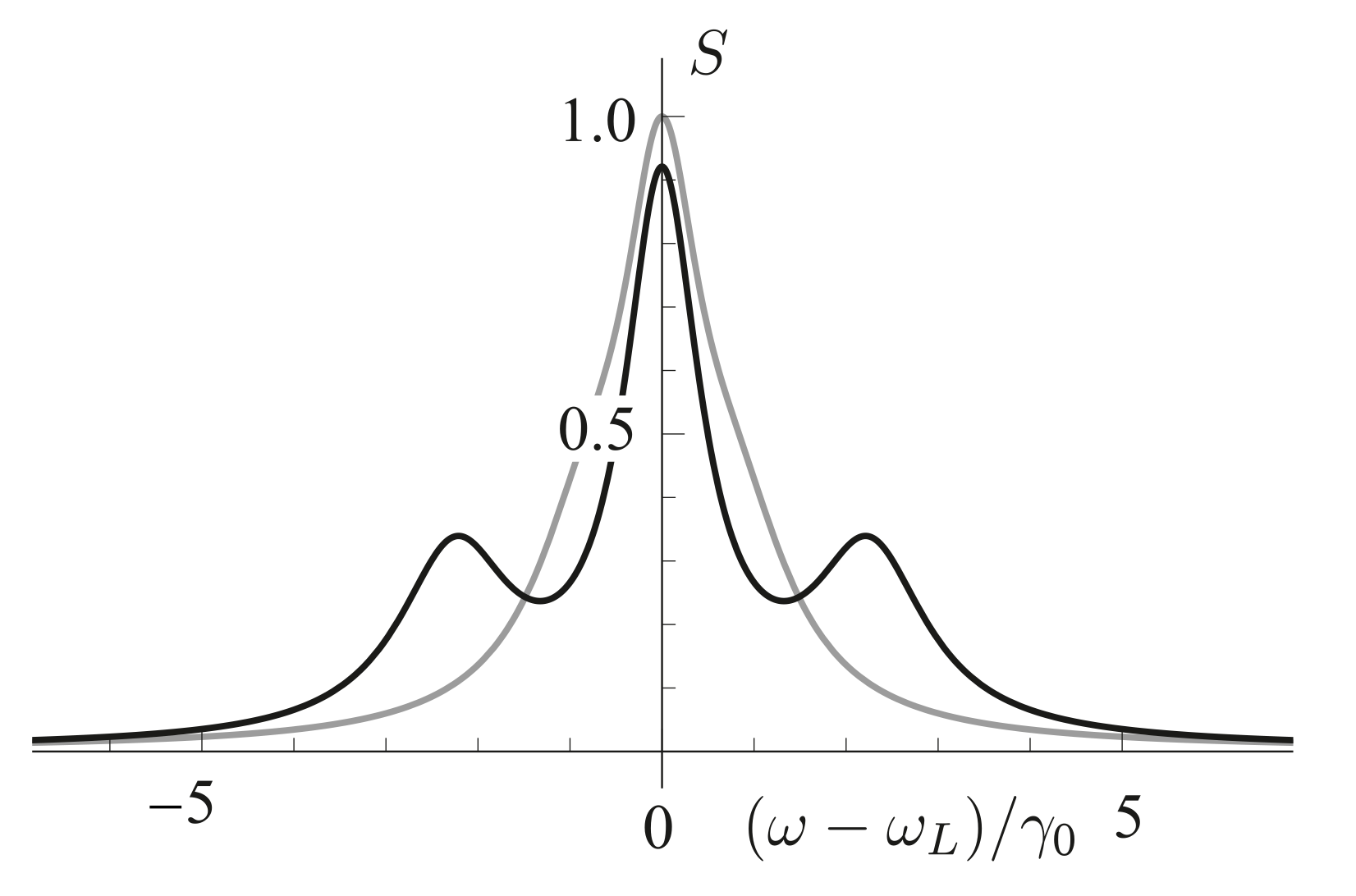
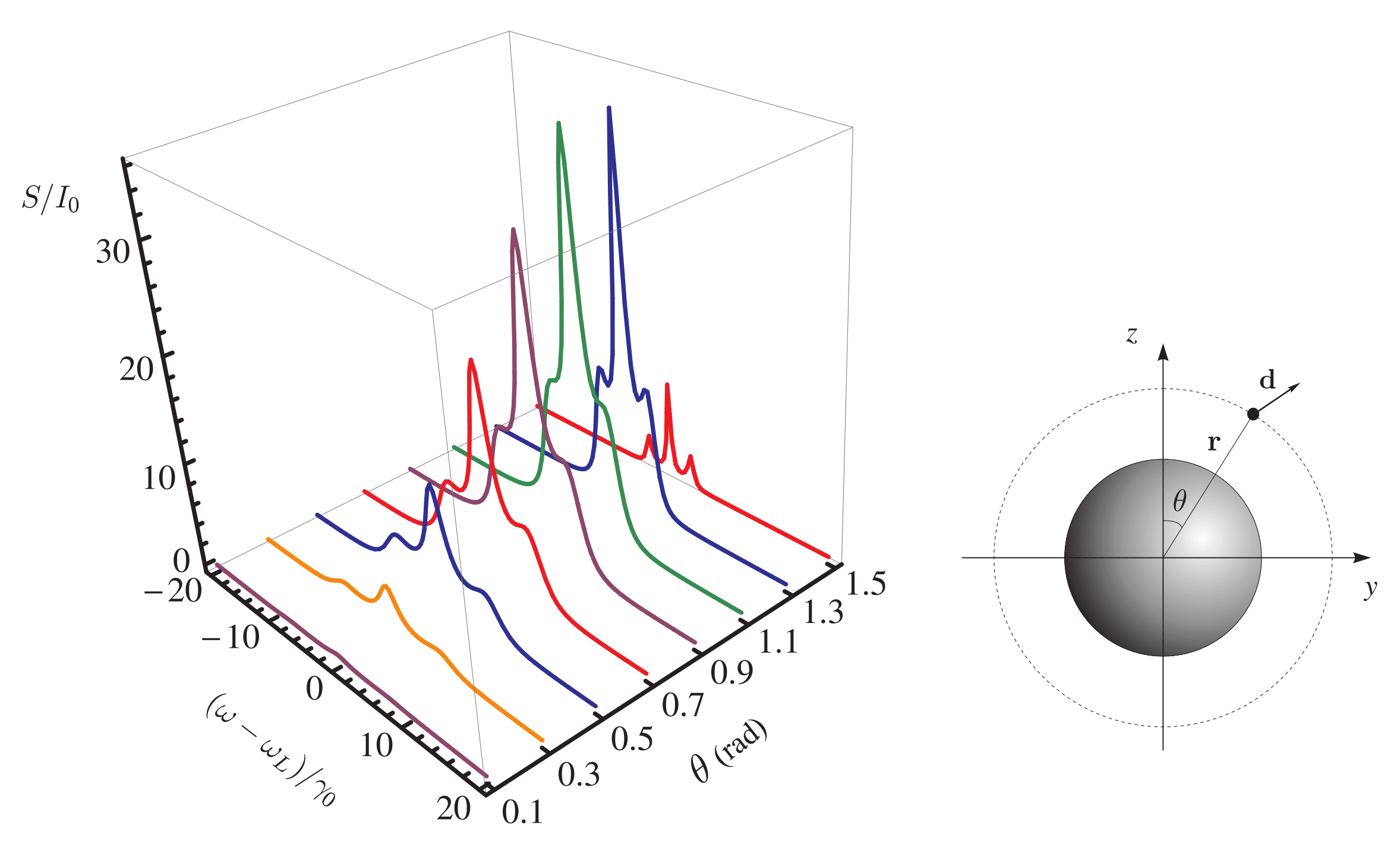

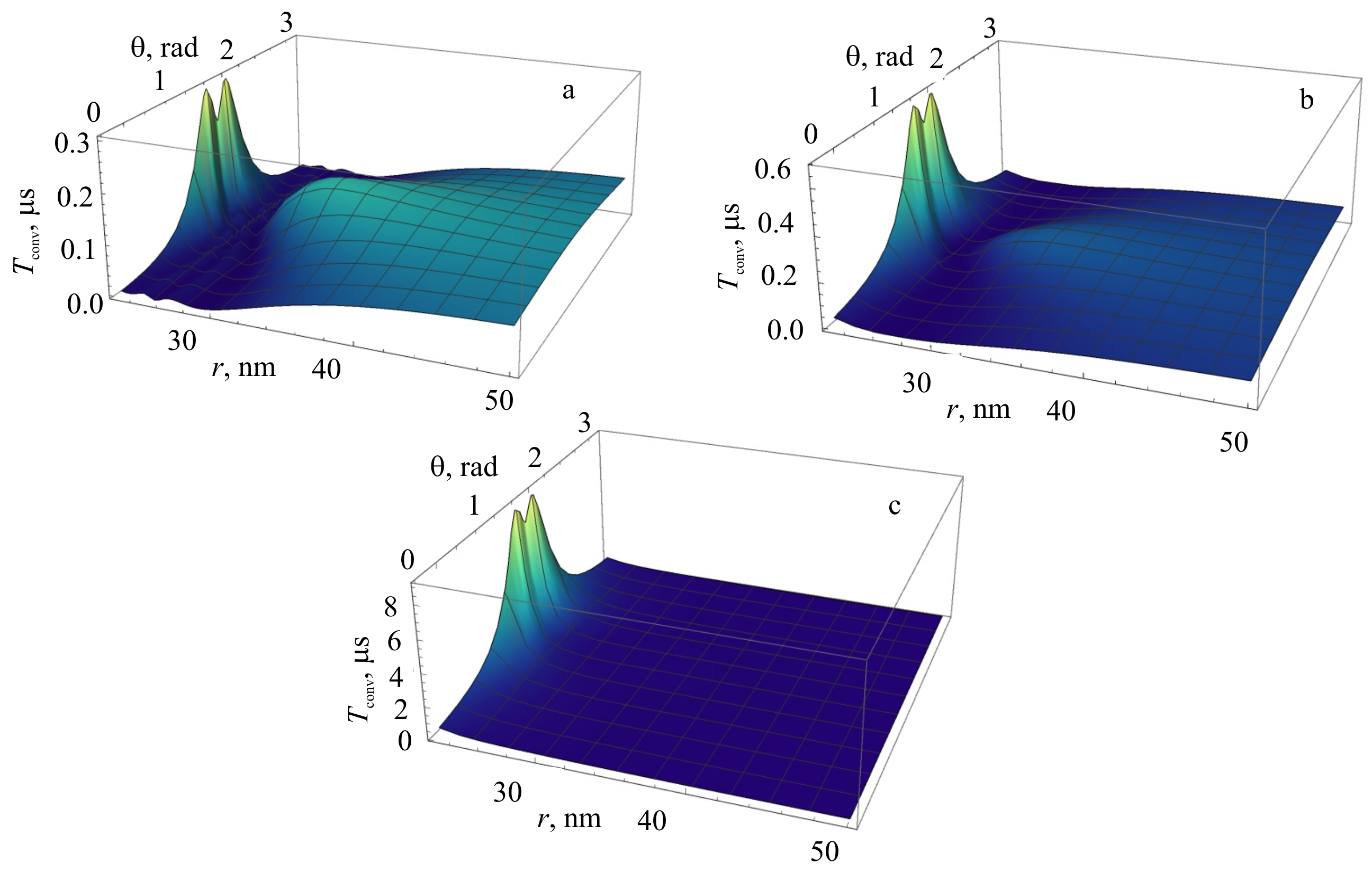



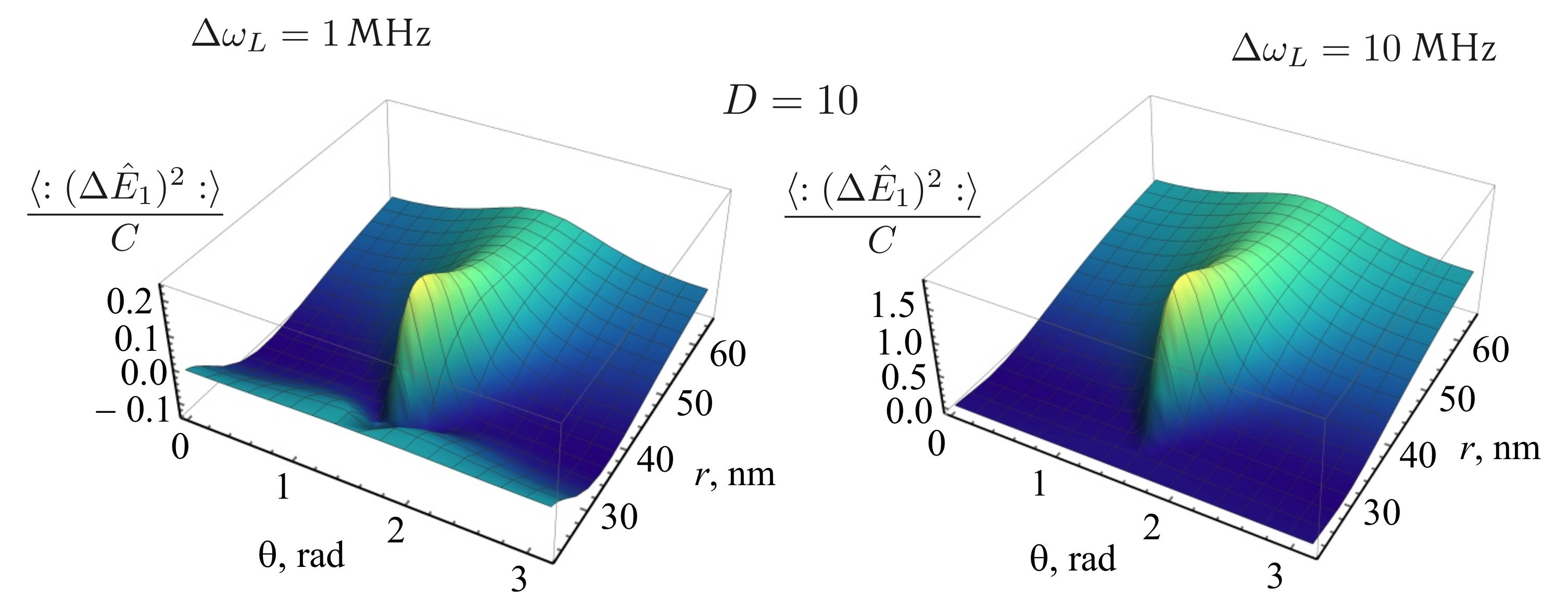

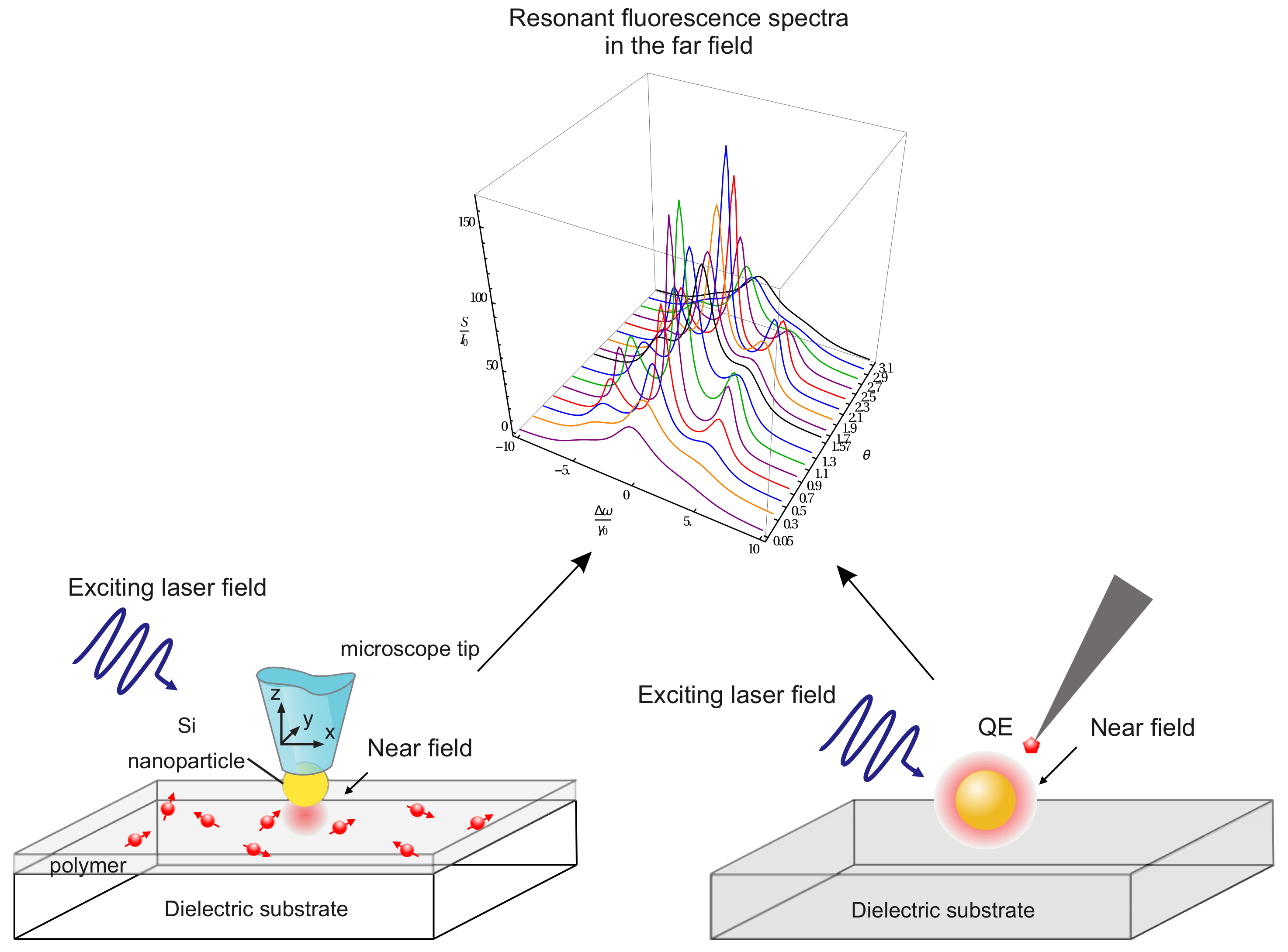
Publisher’s Note: MDPI stays neutral with regard to jurisdictional claims in published maps and institutional affiliations. |
© 2021 by the authors. Licensee MDPI, Basel, Switzerland. This article is an open access article distributed under the terms and conditions of the Creative Commons Attribution (CC BY) license (https://creativecommons.org/licenses/by/4.0/).
Share and Cite
Vladimirova, Y.V.; Zadkov, V.N. Quantum Optics in Nanostructures. Nanomaterials 2021, 11, 1919. https://doi.org/10.3390/nano11081919
Vladimirova YV, Zadkov VN. Quantum Optics in Nanostructures. Nanomaterials. 2021; 11(8):1919. https://doi.org/10.3390/nano11081919
Chicago/Turabian StyleVladimirova, Yulia V., and Victor N. Zadkov. 2021. "Quantum Optics in Nanostructures" Nanomaterials 11, no. 8: 1919. https://doi.org/10.3390/nano11081919
APA StyleVladimirova, Y. V., & Zadkov, V. N. (2021). Quantum Optics in Nanostructures. Nanomaterials, 11(8), 1919. https://doi.org/10.3390/nano11081919





